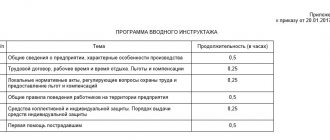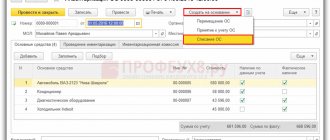Occupational safety and the acquisition by employees of the necessary knowledge and skills in this area must be ensured by the employer. All employees of the enterprise are promptly informed and trained in the rules that guarantee them safe working conditions. Sometimes such instruction needs to be carried out not according to plan, but in connection with certain circumstances that have arisen.
- What are the features of conducting unscheduled training on labor protection?
- Who should conduct it?
- How is this process documented?
We consider all issues related to this type of instruction.
For which employees is unscheduled training ?
The procedure for conducting unscheduled briefings on labor protection
Conducting labor safety briefings is an obligation of the employer, the purpose of which is to ensure the proper level of labor protection (OHS). We continue the series of materials about instruction and offer to understand when it is necessary to conduct unscheduled instruction, what tasks it solves, and how it differs from introductory or repeated instruction.
Unscheduled training is intended for employees who need to familiarize themselves with new information on occupational safety. It is also taken by employees who have interrupted work for 30 or 60 calendar days.
Instructor - who is he?
Unscheduled briefing is usually carried out directly at the workplace itself. Remote conducting is not prohibited either - modern technologies allow the use of all kinds of technical means for this, primarily a computer.
The instructor is usually the immediate supervisor of the work being performed. Its functions can be performed by:
- executive;
- director of operations;
- representative of the management of the workshop or work site;
- master;
- foreman;
- occupational safety specialist, etc.
NOTE! There may be one person being instructed, or a group of employees undergo unscheduled training at once.
When is unscheduled training needed?
- Changes in technological processes, replacement, modernization of equipment, tools or other factors affecting safety and working conditions.
- A break in an employee’s work - in the case of work with harmful and/or dangerous working conditions - more than 30 calendar days, for other work - more than 60 calendar days.
- New instructions and changes to existing ones on occupational safety in the workplace, safe work performance or other technological documentation. In case of changes in legislative, regulatory and legal acts that contain requirements regulating the procedure for performing work that is entrusted to the employee.
- Violation by an employee of occupational safety requirements, if this caused a real threat - an accident, a production accident, etc.
- At the request of officials of state supervision and control bodies, public control.
- By decision of the head of the training organizer or an authorized official.
When is the training carried out?
There are several reasons for conducting such instruction.
Conducting this type of training is important for the employer. In the process of performing production tasks, many nuances appear that need to be outlined to the employee. This is why unscheduled instruction exists.
List of cases for undergoing unscheduled training:
- Changes in production technology. Life does not stand still and everything gradually changes, including technological processes being improved, new equipment being used, new equipment being purchased. This cannot be ignored by the employer. In order for the employee to be familiar with innovations, it is necessary to conduct additional or unscheduled training;
- An accident occurred at work, although this is extremely undesirable, but, alas, the fact of occurrence was recorded. In order to prevent this oversight in the future, all employees engaged in a similar type of activity must be briefed in the form of a conversation, reading the investigation materials and the requirements from the labor protection instructions;
- An incident occurred at the workplace that could have caused an accident, but it did not. This incident cannot be ignored, as it may happen again. As a rule, it is necessary to prepare an administrative document for the enterprise and familiarize all employees, and instruct those engaged in similar activities in the prescribed manner;
- The employee had not worked for two months and could well have forgotten not only the subtleties of the technological process, but also safe work practices. If he performed particularly dangerous work, then this time is halved - 30 days. After a long absence, the manager gives him a briefing;
- Unscheduled instruction is carried out on the basis of a recorded occupational disease.
Employees performing the same functions as a result of which such circumstances occurred are given additional training.
When and where do unscheduled instructions take place?
The timing of an unscheduled briefing depends on its reason. If this is a change in the technological process, the use of new equipment, etc., then instruction must be carried out before starting work under new conditions. In case of violation of occupational safety requirements at similar enterprises, accidents, etc., the period for conducting labor safety briefings is set by the manager and responsible employee.
The location of the unscheduled briefing is determined based on its content. If it is carried out due to changes in production processes, an accident, replacement of equipment and similar factors, then it takes place at the workplace. If the reason was changes in legislation that relate to general occupational safety issues, and which can be sufficiently covered without reference to the premises, then the instruction can be carried out in a conference room or meeting room.
Why was instruction needed outside of the plan?
Should training in certain basics of labor protection be carried out outside the approved plan and program? This requires a certain reason provided for by labor legislation.
GOST 12.0.003-90 regulates the rules for conducting all elements of training in the basics of labor protection. Unscheduled briefing is considered one of the most important procedures for special training of employees to prevent injuries and other accidents, along with initial briefing.
Reasons for unscheduled briefing:
- reaction to a sudden emergency situation;
- the need for training in response to changes in working conditions, technology or equipment.
Reasons for scheduling an unscheduled briefing
They fit into the two reasons listed above. Specific reasons requiring new training, noted in regulations, may be:
- introduction of new or revised standards, instructions, rules related to labor protection at a given enterprise;
- introducing any changes to existing labor safety regulations;
- introduction of new factors into the production process: change or renewal of equipment, tools, raw materials, replacement of technologies, etc.;
- requirement set by supervisory authorities;
- identified violation of labor safety requirements committed by employees or students, which led or could lead to damage to health or equipment;
- information received about accidents or accidents at similar enterprises;
- an interval of more than 2 months between permits to work, and for work in conditions of increased danger - more than 1 month.
Is it necessary to provide labor safety training for remote workers ?
More danger means more training requirements
If production is characterized by a greater degree of danger, in order to prevent injuries and emergency situations, unscheduled briefings must be carried out for additional reasons. These may include:
- getting injured at work;
- a month's break in the employee's work activity;
- the occurrence of an occupational disease in one or more employees due to working conditions;
- forced change of schedule or stop of the work process due to gross violation of labor safety rules;
- the employee is transferred to a new workplace;
- the employer or control body has issued a corresponding order.
IMPORTANT! If the reason was an accident or injury at this or another workplace. Then the briefing must be carried out “hot on the heels” - no later than three days after the incident.
How to conduct an unscheduled briefing?
In order to organize labor safety training you need:
- Have a document that clearly defines the need for unscheduled training. This could be a notice of an accident, accident, fire and their consequences, a new version of a law or regulation, an order from a regulatory body or a higher organization, etc. This document will need to be referenced in the order for unscheduled instruction on labor protection.
- Prepare an order that will indicate the reason for the instruction, the instructor, the location, the persons who are required to undergo it and the timing of the instruction.
- Prepare and approve a training program. It can be common for all instructees or separate for workers of different positions and professions. Before approval, the unscheduled instruction program is agreed upon by the labor protection service and the trade union committee.
- Organize instruction: explain new information to employees, test knowledge, make entries in the journal.
Documentation and registration
Records of unscheduled briefings, as well as other forms of reporting on training in the basics of labor protection, fall under administrative responsibility. The logbook for such briefings is approved by GOST 12.0.004-90.
The following information is entered into this log:
- about the reason for conducting the briefing outside the plan;
- its date;
- personal information and position of the instructor;
- about persons who have undergone instruction;
- about its volume and content.
This information is sealed with the signatures of the instructor and each person instructed.
If an employee's personal card , information about unscheduled briefings is also entered into it, and the number or name of the corresponding program is indicated.
Peculiarities
The peculiarity of unscheduled briefings is the absence of a pre-developed and approved program for conducting labor safety briefings of this type. In order to prepare for it as much as possible, the person responsible for labor protection in the organization should draw up a procedure for developing and approving a program for typical cases. Typical cases include changes in the requirements of regulatory documentation, accidents, identification of employees with gaps or erroneous knowledge of occupational safety.
When unscheduled instruction on labor protection is carried out due to changes or the introduction of new rules, codes, GOSTs and other regulatory documentation of state significance, a state inspector or employees of a specialized training center can be invited to conduct it. One such organization is EcoStandard group. It includes a Training and Methodological Center, which develops training programs taking into account the latest changes in legislation and current cases from the practice of Russian companies.
Control of absorption
Instruction involves mandatory monitoring of the acquired knowledge and skills of trained employees. The form of control is set individually:
- it could be a survey
- written report,
- practical test of skills,
- The use of computer training programs and other technical training aids is not excluded.
If the mastery of the material is considered unsatisfactory, such an employee is not allowed to continue the work process. He will need repeated instruction after a certain time.
How exactly to remove an employee who has not undergone training and testing of knowledge and skills in the field of labor protection?
How is the briefing completed?
A signature is placed in the journal.
The preparation of briefings should not be left to chance, much less neglected at all. Perhaps nothing will happen at first, but one day “thunder will strike” and signatures will have to be collected retroactively.
At enterprises, all managers must have training logs in the established form. They should reflect the numbers of instructions or regulatory documents according to which the instruction is carried out.
The same line must contain the signatures of the person who carried out and received the instructions, with the obligatory date.
If you do not put the date and year, then it will hardly be possible to prove that the conversation was held on that very day.









